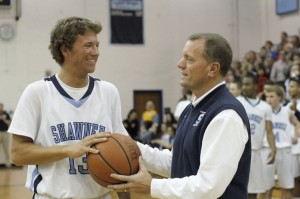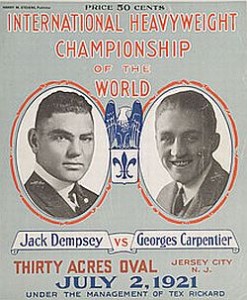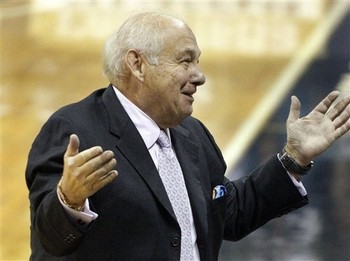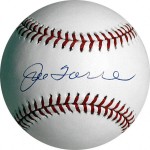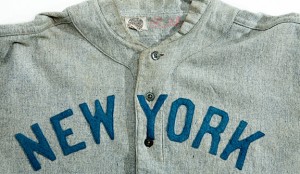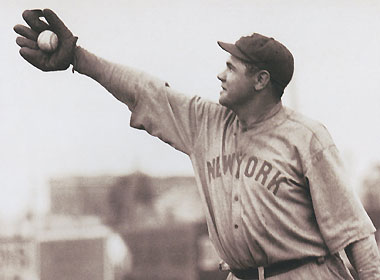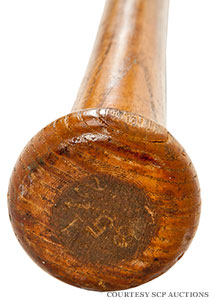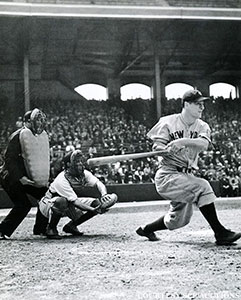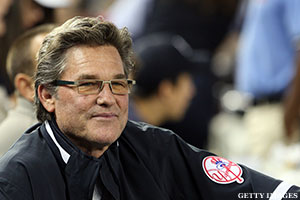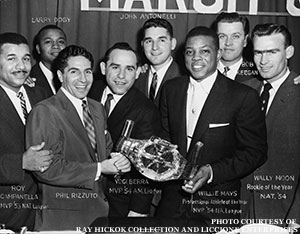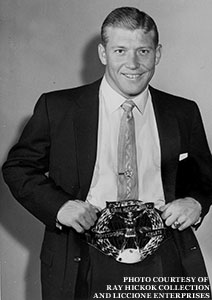‘The Wire’
PSW Editor DB Lilley Records Hole-In-One
Philly Sports Wire’s Don Lilley registered a hole-in-one at the Rossmoor Golf Club during play at the Club’s regular afternoon matches on Wednesday, January 30th. It was Don’s first hole-in-one in competition.
The ace came at the 120 yard par three 4th hole at Rossmoor, which is located in Monroe Township, New Jersey. The Rossmoor Golf Course was built in 1966 and designed by renowned golf course architect Desmond Muirhead.
The 4th hole at Rossmoor features an elevated green protected on the right and left side by bunkers, as well as, a large sand trap at the rear of the putting surface.
Muirhead, who was born in England in 1923, designed many notable golf courses including the Stone Harbor Golf Club, also located in New Jersey. Maybe his most famous design is the Muirfied Village Golf Club, owned by Jack Nicklaus and located in Columbus, Ohio. Muirfield Village is the venue for the annual Memorial Golf Tournament on the PGA Tour. The Memorial has been won by some of the greats of golf, including Tom Watson, Greg Norman, Ernie Els, Tiger Woods and Jack, himself.
Rossmoor Golf Club Course Map
NJAC Rookie of the Week
JOSH BORRELLI • Rowan University – New Jersey Athletic Conference
Freshman • Guard • Medford, NJ – Shawnee
Borrelli earns the first NJAC Rookie of the Week selection after helping the Profs finish 1-1 during the Widener Tip-Off Tournament.
Borrelli was one of four players for the Profs to score in double digits, as he recorded 10 points and added an assist during an 89-60 consolation game victory over Berkeley.
In the first game of his collegiate career, Borrelli came off the bench and went 4-of-5 from the field, shooting .800 for the game.
Moravian’s Connection To “The Card”
The T206 “Gretzky” Honus Wagner is the most famous baseball card in the world. And, as the art world readily illustrates, it may be that no matter what was done or not done to “The Card,” its value really does lie in the eye of the beholder. D. Rovell, ESPN
Mastro/Honus Wagner Card Update Video – Click Screen Above
Bethlehem, PA – It was between 1973 and 1975 that the most famous baseball card in the world may have resided in a small door-less closet in one of the colorfully named dorm rooms, the “Ice Palace” was one, within the confines of the Omicron Gamma Omega fraternity house, the OGO house for short.
OGO is a chartered fraternal organization situated on the campus of Moravian College, a small liberal arts institution of higher education located in the Lehigh Valley of Pennsylvania. Moravian, notable in its own right, is one of the “Colonial Colleges” of the original thirteen colonies and is regarded as the sixth oldest college in the United States.
It was here in the early 70’s that one William “Billy” Mastro and yours truly attended Moravian College and subsequently pledged and joined the heavily athletically oriented OGO fraternity. For several semesters Billy and I had adjoining rooms within the fraternity house and we would often spend time in his room reviewing his recent baseball card purchases and making arrangements to spend some of his newly acquired bounty on pizza and beer.
By this time, Billy had put together one of the most impressive baseball card collections assembled to date. The $2.8 million Honus Wagner card, which was later owned by Wayne Gretzky, was purchased for Bill when he was in high school to start off his collection. “The Card”, acquired by his parents for the then astronomical price of $12,500, turned out to be quite an investment.
To say the least!
Billy, who was known on campus as a “free spender”, was always in possession of large amounts of extra cash. He was known for always having the latest in creature comforts; nice furniture, clothes, cars, etc. And always one to share with friends. We all knew that the bankroll was a result of Billy’s part-time card swapping business, in which he always seemed to make a profit on each and every trade.
Mastro would keep part of his collection and any newly acquired cards in a small closet at the back of his single suite. Bill’s room was one of the two suites within the house that were usually reserved for brothers of high standing, brothers who had a long tenure in the house, or brothers (Billy) who had enough money to “buy” the lease from the rightful “tenant”, if you know what I mean. I, myself, roomed in the second suite on the opposite side of the house during my senior year.
One of the last times I saw Bill was in 1976 at my wedding, in which he participated as one of my groomsmen.
I don’t remember ever seeing the famous card, but who knows, a $2.8 million treasure may have graced the halls of the venerated OGO house.
By: DB Lilley, April 2013
Mastro/Honus Wagner Card Video – Click Screen Above
South Jersey’s Bill Guille With Famous Student
Local “Ski Instructor to the Stars” Bill Guille is shown here with his famous student, none other than the host of “Late Night”, Jimmy Fallon.
I started BG on his 40 year journey to fame by introducing him to the original South Jersey snow skiing legend called Ski Mountain, located in Pine Hill, New Jersey. Bill and I both lived in nearby Laurel Springs, New Jersey and graduated from Collingswood High School in 1971. Bill is currently a ski instructor at Whiteface Mountain, located in Lake Placid, New York.
Ski Mountain, which was later reincarnated as Action Mountain, disappeared from the local landscape well over thirty years ago. An upscale golf club called Trump National Golf Course of Philadelphia now occupies the same property where once stood the famous ski resort.
By: DB Lilley, January 2013
The Day I Met “The Champ”
Watching an episode of the HBO series “Boardwalk Empire”, in which Heavyweight Champion of the World Jack Dempsey is portrayed training for a boxing match in Atlantic City, NJ in 1921, reminded me of an event that took place almost 40 years ago.
It was a dreary day in early spring of 1972, damp, cold and windy, not uncommon for the month of March. I was a freshman at Moravian College in Bethlehem, Pennsylvania and about to join one of our College’s fraternities, Omicron Gamma Omega, or OGO, for short. Our fraternity was populated by many of the school’s outstanding athletes, so much of the activities at the house centered around sporting endeavors, and occasionally an impromptu boxing match or two, with gloves, of course.
Part of the initiation process to join the fraternity, of which this event was only a small part, required a select group of “pledges” to take a trip to New York City for what was billed as a “scavenger hunt”. We were to be dropped off in the city with no money and were each given a list of items to be collected from various sites located within the city. Each item was then to be returned to our “big brothers” so they could assess how well we completed our task and presumably to determine if we were worthy enough to become “full fledged” OGO brothers.
Almost 40 years later, I can’t remember all of the places I had to visit, Washington Square in Greenwich Village was one, but the place that sticks out in my mind the most was Jack Dempsey’s Broadway Bar & Restaurant, located at 8th Avenue and 50th Street, in what is commonly known to most visitors as Times Square – My mission once I arrived at the restaurant was to get an item which had the Jack Dempsey name on it. It could be a menu, or maybe a business card, for instance.
When I entered the bar there were several people located at the back of the room next to a booth along the rear wall of the dining room. There, sitting at the table, was the Champ himself, Jack Dempsey, holding court, as he must have been doing for almost a quarter of a century. I approached the table and shook hands with Mr. Dempsey, by now almost 77 years old. He greeted us with a hello, and said he hoped we were having a good time. It was a once in a lifetime experience !
The restaurant closed for good two years later and Mr. Dempsey died in 1983 at the age of 87.
Oh, and what about the souvenir for proof of my visit? It was a green plastic swizzle stick from the bar that read “Jack Dempsey’s Broadway Bar”
By: DB Lilley, November 2011
Jack Dempsey – Atlantic City, 1921 (Basis For Boardwalk Empire Episode)
In 1921 Doc Kearns and George Lewis “Tex” Rickard, a fight promoter, set up a match for the world heavyweight championship with Dempsey and Georges Carpentier, the European champion. The boxing committee considered Atlantic City for the location of the fight. New Jersey State Boxing Commissioner John S. Smith thought a temporary stadium could be built in time at the airport, but the decision for the location of the match was changed to Jersey City, New Jersey. The date was set for July 2, 1921.
Carpentier’s training camp was set up in secluded Manhasset, Long Island. Dempsey started training in Long Hill, New Jersey near Summit, but Atlantic City offered a location at its new airport and erected a grandstand so fans could watch his workouts. Dempsey and his entourage arrived in Atlantic City on May 6, 1921, and checked in to the Hotel Alamac. At City Hall, Mayor Edward L. Bader presented him with the ceremonial key to the city. Dempsey’s training camp at the airport became a popular site as the public came to watch his daily workout sessions. Doc Kearns charged admission as the daily crowds numbered 1,000, collecting one dollar per person. Dempsey’s training also included Boardwalk strolls and running on the beach. He had many different sparring partners during the months he trained in Atlantic City.
On June 29, 1921 he concluded his training and left the city soon after, aboard a chartered Pullman coach attached to a Reading Railroad train. He headed for the fight at Jersey City accompanied by Teddy Hayes, his trainer, Trant, his bodyguard and Mayor Bader, who had become Dempsey’s friend and who hoped to attract future boxing matches to Atlantic City. The championship fight, called “the battle of the century,” took place in Boyle’s Thirty Acres Stadium in Jersey City, and Jack Dempsey knocked out Georges Carpentier in the fourth round. The champ returned to Atlantic City in August 1921 for rest and relaxation.
Courtesy Of “The Atlantic City Experience”
Shawnee HS Star On “Good Morning America”
Explains Rare Skin Disease Requiring Tanning
Oldest Known Baseball Card Goes To Auction
A 148-year-old team photo of the amateur Brooklyn Atlantics, which the Library of Congress calls “the first dated baseball card,” might fetch $100,000 or more when it goes up for auction next month in Maine. Problem is, nobody knows exactly how much it’s worth.
Only two Atlantics cards are known to exist — the other having been in the Library’s archives since the 1880s, when the photographer Charles Williamson submitted the photo for copyright.
Of course, this card is not like the contemporary baseball cards your mom threw away when she cleaned out the attic back in the ’70s. It’s not even like the tobacco cards of the late 19th century, either. It’s an original photograph, mounted on a card, that features nine uniformed players gathered around a bearded manager in a suit who appears ready for a Civil War reenactment. Or maybe even the real thing. It was 1865, after all. None of the players (or the skipper) have been identified by individual name.
The Brooklyn team created the card as a promotional stunt and because it was a frequent league champion. Hey, you got a problem with that?
Relegated to the dustbin of history for several generations, the card was found at a yard sale by accident (of course) when an otherwise unidentified man in northern Maine bought a photo album, old Coke bottles and two oak chairs for less than $100. That’s some find.
According to its web site, the Saco River Auction Co. has scheduled the card’s auction for Feb. 6. Saco River also sold an 1888 card of Michael “King” Kelly for $72,000 in the summer of 2012 (which is how the seller of the Brooklyn card knew to contact Saco about his find). FYI, the most expensive card ever sold at auction was a 1909 Honus Wagner, which went for $2.8 million in 2007. Imagine how the moms who tossed one of those might feel if any ever knew. Dave Brown, Yahoo
Rollie Massimino Still Teaching “Roundball”
JUPITER, FL – Our crack reporter Bob Glasson spotted former Villanova University basketball coach Rollie Massimino on a recent visit to my golf buddy Nick Chiantese’s popular Jupiter, Florida restaurant, Nick’s Tomatoe Pie.
You may remember that Rollie lead the Villanova Wildcats to one of the greatest upset victories in college basketball history by beating heavily favored Patrick Ewing and the Georgetown Hoyas to capture the 1985 NCAA Division I Men’s Basketball Championship.
Massimino, who once turned down an offer to coach in the NBA with the New York Nets, now lives in Florida and currently coaches the men’s basketball team at Northwood University. Northwood, which is located in West Palm Beach, Florida, plays in the NAIA.
By: DB Lilley, March 2011
Jack Nicklaus At PGA National
PALM BEACH GARDENS, FL – Former Bordentown, NJ resident and buddy Bob Glasson reports that he and the members of his golfing foursome bumped into Jack and Barbara Nicklaus at “the 19th hole” after a recent round on the “Squire” course at the PGA National Golf Club in Palm Beach Gardens, Florida. PGA National is the home of the PGA Tour’s Honda Classic.
Jack and wife, who live in nearby North Palm Beach, were there to attend a fund raiser sponsored by fellow PGA tour star Ernie Els. Jack graciously signed Bob’s Ryder Cup golf cap, which Bob says will be displayed prominently in his golf trophy case at home in Jupiter, Florida.
By: DB Lilley, March 2011
Sandy Koufax Back Working With The Mets
JUPITER, FL – Yours truly had the opportunity to meet Hall of Famer Sandy Koufax in Florida last week. The Dodger great is currently working with New York Met Chris Capuano, the 32-year-old former Milwaukee Brewer pitcher who turned in three strong innings for the Mets in a recent Grapefruit League game at the Mets’ Port St. Lucie complex. Koufax, who resides in the area, is a regular customer at my golf buddy Nick Chiantese’s popular Jupiter restaurant, Nick’s Tomatoe Pie.
By: DB Lilley, February 2011
2011 NY Baseball Writers Awards Dinner
NEW YORK, NY – I had the opportunity to attend the New York Baseball Writers’ Association (BBWAA) annual dinner held at the New York Hilton in mid-town Manhattan last night. Had a chance to chat with several of the honorees, including Phillies pitcher, Roy Halladay (2010 Cy Young Award), retiring MLB managers Joe Torre, Lou Pinella and Bobby Cox (2010 Mickey, Willie and the Duke Award), and local Daily News sportswriter Bill Conlin (2010 Baseball Hall of Fame Writers inductee). Also, stopped by the Phillies table and talked for a bit about the upcoming season with Phillies skipper Charlie Manuel, GM Ruben Amaro Jr and Phillies managing partner, Dave Montgomery.
By: DB Lilley, January 2011
Shawnee HS Star On “Good Morning America”
Explains Rare Skin Disease Requiring Tanning
The Babe’s Jersey Going To Auction
The 92-year-old professional-grade wool flannel jersey has enough soiling, stains and fabric repairs to establish that its owner tumbled after fly balls and slid into second base. More often he trotted around the bases in his signature choppy steps.
The Y in the words “NEW YORK” is embroidered on the double-thick button placket, proof to experts that the road jersey was made circa 1920. Stitched next to the Spalding manufacturer’s label on the collar are these letters in faded pink script:
Ruth G.H.
Since one George Herman Ruth was purchased by the New York Yankees from the Boston Red Sox on Jan. 5, 1920, and first wore the uniform of his new team two months later, top authenticators are confident the jersey likely was worn by Ruth that season, making it perhaps the most valuable piece of baseball memorabilia ever.
And that season was landmark. On the strength of Ruth, the Yankees drew nearly 1.3 million fans at the Polo Grounds, becoming the first major league team to exceed a million in attendance. World War I was over, prohibition began, the ’20s began to roar, and Ruth swiftly became an alluring national symbol of power, excess, intemperance, exuberance and excellence. He hit 54 home runs in 1920, obliterating his own major league record of 29 set a year earlier with the Red Sox. No other team in baseball hit more than 50, and no other individual hit even 20.
Ruth, 25, would emerge from his lavish apartment at the Ansonia Hotel on Broadway and 73rd Street, ignore traffic laws as he drove his roadster to the Polo Grounds and then cheerily wade through a throng of admirers and disappear into the clubhouse, where he’d pull his jersey over a taut torso that eventually would become bloated by an abundance of beverages and animal protein, button it up and begin another day as the best baseball player in the world.
Here it is 2012, and the jersey endures as a memento of a life and a time etched deeply in Americana. It was privately owned for decades and made public at the Babe Ruth Museum in Baltimore from 2004 to 2009. It then was sold to a collector, who in late April will put the jersey up for auction. Experts say the price ought to exceed the $2.8 million paid in 2007 for a pristine T-206 Honus Wagner tobacco baseball card.
“This is simply the finest sports artifact we’ve handled in our 30-year history,” said David Kohler, president of SCP Auctions, the online firm handling the sale. “The historical impact of Ruth’s emergence in the Big Apple in the early 1920s, combined with the jersey’s superb original condition, makes this a sports treasure of the highest order.”
Sports memorabilia auctions are big business, and some of SCP’s recent online baseball sales included the bat the Dodgers’ Kirk Gibson used to hit his historic home run in the 1988 World Series ($576,000), Lou Gehrig’s last home run bat ($403,000) and a program honoring colorful 19th-century Red Sox hero King Kelly ($215,000).
But memorabilia experts say nothing captures the imagination – and opens the checkbooks – of collectors like Babe Ruth. The bat Ruth used to hit a home run in the first game at Yankee Stadium, on opening day in 1923, sold for almost $1.3 million in 2006. The contract of his sale from the Red Sox to the Yankees sold for $996,000 in 2005. And the price paid for this jersey will dwarf them all, Kohler said.
A reason, of course, is that Ruth transcended baseball. In the first era of American celebrity, in the city that seemed the center of the universe, his exploits on and off the field made him a folk hero even during his career. And it all began in 1920, seven years after he escaped a childhood spent mostly in a Baltimore reform school and broke into the big leagues with the Red Sox as a dominant left-handed pitch.
He soon established himself as too valuable a slugger to stay on the mound, and it turned out he was too valuable to stay in Boston, too. The owner of the Red Sox, Harry Frazee, was overleveraged and periodically raised cash by selling players – usually to the Yankees, a chronic second-division team that got a taste of winning by finishing third in the American League in 1919.
Yankees owners Jacob Ruppert and Tillinghast Huston recognized that the outsized slugger who had bashed an unthinkable 29 homers in 1919 would be a drawing card. They purchased Ruth for $100,000 – double the previous record paid for a player – and Ruppert also gave Frazee a $300,000 loan secured by a mortgage on Fenway Park.
Ruth, for his part, was unhappy with his Red Sox contract that was to pay him $10,000 a year through 1921. He negotiated a total of $41,000 for two years with the Yankees, and the deal was completed. Ruth reported to spring training in Jacksonville, Fla., in March, and his new uniform was waiting in his locker.
The sale set in motion the supposed Curse of the Bambino. The Red Sox had won all five World Series they reached before selling Ruth, including three with the big left-handed hurler on the roster. Ruth had a record streak of 29 consecutive scoreless innings in the 1916 and 1918 World Series.
The Yankees reached their first World Series in 1921 and made six more appearances during Ruth’s career, winning four. They’ve added 23 more World Series titles since. The Red Sox didn’t win another World Series until 2004.
The nickname “Babe” had come from older teammates when Ruth was a naïve minor leaguer playing for Baltimore in 1914. The “Bambino” moniker originated six years later from Italian immigrants living in Manhattan, according to Robert W. Creamer’s splendid biography of Ruth titled, “Babe: The Legend Comes to Life.”
“The rhythm and alliteration and connotative impact of the Italian word for babe, bambino, made the nickname a natural,” Creamer wrote. “In time, headlines would say simply, ‘BAM HIT ONE.’ ”
The bat Ruth used to hit No. 50 in 1920 he allowed auctioned to raise money to help starving Armenians in Turkey, according to Creamer. No. 54 came in the season’s last game. The record lasted only a year: Ruth hit 59 homers in 1921 and 60 in 1927. He hit 714 home runs in his career, a record that stood until Hank Aaron broke it in 1974.
Only a few pieces of Ruth memorabilia have survived; the jersey to be auctioned at www.scpauctions.com is one of four of his unrestored game jerseys known to exist. Call it a Ruthian opportunity for a collector with deep pockets and as deep an appreciation for baseball lore.
The Top Ten Golfing Presidents
Check Out The Video
Kurt Russell And The Yankee “Iron Horse”
Consider the bat a baton, handed from a distinctly American sports legend on his last legs to a youngster about to embark on a distinctly American adulthood. Just don’t call it pure Hollywood: Bing Russell knew fact from fiction, and the story of Lou Gehrig giving him the last bat he used to hit a home run is reality without a show, not yet anyway.
SCP Auctions is currently taking bids on the bat, and it’s projected to be one of most valuable baseball pieces ever sold. How it went from Gehrig’s python-like grip to the trembling hands of a 12-year-old boy in the dugout to safekeeping for more than 70 years is a fascinating tale, one that Bing’s children (who include veteran leading man Kurt Russell) and grandchildren (who include former major leaguer Matt Franco) want made public.
Bing died in 2003 at 76. Kurt starred in the acclaimed sports movie “Miracle” in 2004. Matt’s 20-year pro career ended in 2006. All the while, the bat rested under an umbrella stand in the home of Kurt’s sister and Matt’s mom, Jill Franco.
Matt visited her earlier this year, and there it was. He lifted the bat, so heavy, so formidable, just the way he remembered the first time he held it as a kid. He thought about his grandfather, the man the family called “Pa,” how he’d traveled to every one of the dozen or so minor and major league cities Matt played in just to watch his at-bats. The pride he felt. The tales he told.
“It’s time the world knows Pa’s story, and the best way to tell it by getting this bat to someone who can display it,” Matt said to his mom.
They called Kurt and talked it over. The decision came down to letting the lumber breathe.
Get it out from under the umbrella stand and into the sunlight. Let it become a conduit connecting Lou Gehrig’s stately greatness to Bing Russell’s rollicking life to new owners who ideally would display their acquisition. The story might spread.
Turns out it’s not the first auction the bat’s been through. Shortly after Bing turned 70, he looked around and decided it was time to de-clutter his house and disperse the possessions. Memorabilia, somebody called it. He said, no, it’s a lifetime. He’d spent his adolescence in the Yankees dugout and then became an actor, owner of a ballclub, father of an even more famous actor, and grandfather of a big leaguer.
Yes, Bing did a whole lot and accumulated magnificent memories. And because he’d taken a piece with him at every turn, his home was full of interesting stuff. So he and his wife, Lou, summoned their four children and said let’s have some fun, let’s have a family auction.
It was a draft, really, youngest to oldest. Daughters Jamie and Jody treasured their dad’s roles as the deputy sheriff in “Bonanza,” as Robert in “The Magnificent Seven” and his dozens of other parts in TV shows and films. Their picks reflected that. Kurt, whose own acting career in films ranging from “Backdraft” to “Silkwood” to “Tombstone” overshadowed a deep love of baseball, took seats from the original Yankee Stadium given to his dad by pitcher Lefty Gomez, who’d been a father figure to Bing.
Jill’s first pick was an old wooden sign from a lake in Maine where the family vacationed when she was a little girl. When it came to keepsakes, sentiment won out over resale value. Jamie, Jody and Kurt made their second-round picks and still the Gehrig bat leaned against the wall. Maybe Jill’s siblings deferred because Matt played for the New York Mets at the time.
Before she took her second pick Jill asked why she had the last pick every round just because she was the oldest. Bing agreed that the draft should reverse each round thereafter. And that gave Jill two picks in a row.
She took a different bat to end the second round, one Joe DiMaggio had used that was signed by the entire 1941 Yankees and given to Bing near the end of his eight-year childhood association with the team. He wasn’t a bat boy or a clubhouse attendant, more of an errand boy the players liked having around. He’d sneak them peanuts, even hot dogs, against the wishes of manager Joe McCarthy, who forbade eating during ballgames. Bing was home-schooled, so he was able to travel with the team and do whatever the players asked. He sat in the dugout during games.
The family auction continued, and with her newly acquired first pick of the third round, Jill selected the bat Gehrig had handed her father upon returning to the dugout April 13, 1939. It was the Iron Horse’s second homer of the game, an exhibition against the Brooklyn Dodgers in Norfolk, Va. Already weakened by amyotrophic lateral sclerosis, what would come to be known as Lou Gehrig’s disease, he played only eight games when the regular season began before retiring. He died two years later at 37.
“My grandfather would bring out that bat every time we had people over and the conversation turned to baseball,” Matt Franco says. “He’d pass it around the table and he’d tell stories about all the guys on those teams.”
The coolest aspect to Kurt Russell was that the bat was handed directly from Gehrig to Bing. His dad’s story never changed: “The bat boy, Timmy, picked it up while Lou was circling the bases and gave it to Lou when he touched the plate. Lou carried it back to the dugout and handed it to me.”
It’s all been verified. SCP Auctions sent the bat to a third-party authenticator that confirmed it was one of the last professional models shipped to Gehrig by Hillerich & Bradsby. The venerable bat-making company keeps meticulous records, and an invoice shows the shipment of four bats was delivered in August, 1938. It was Gehrig’s last order.
The highest auction price for a bat was $1.265 million in 2005 for the one Babe Ruth used to hit the first home run at old Yankee Stadium on opening day in 1923. Shoeless Joe Jackson’s Black Betsy is the second highest, selling for $577,610 in 2001, and Kirk Gibson’s 1988 World Series home run bat went for $576,000 last year.
SCP managing director Dan Imler puts the Gehrig bat in the same league as the Jackson and Gibson bats: “This is the single finest Lou Gehrig artifact we’ve witnessed in the thirty-two year history of our company. It has all the characteristics of a record-setting piece.”
The auction ends Nov. 19. Two other of Bing’s bats are also taking bids: The one DiMaggio used that the 1941 Yankees signed and one used by Babe Dahlgren, who replaced Gehrig at first base in 1939.
Bing grew up in St. Petersburg and would hang out during spring training at the Yankees facility there. One day in 1935 at age 9 he outraced other kids for a foul ball only to have to fight them off to keep it. Lefty Gomez, the ace of the Yankees’ pitching staff, noticed the kids scuffling, picked up Bing by the collar and said, “Kid, you’ll never have to fight for a ball the rest of your life.”
Bing spent the next eight years with the team and was in the dugout for six World Series. Gomez became a father figure to him, saying, “Bing was the only person who took it harder than I did when I lost.” Although Gehrig would shoot him a grin and a nod, Bing kept a respectful distance because he was in awe of the quiet superstar first baseman.
When spring training rolled around in 1939, it was clear something was wrong with Gehrig. Bing would give Gomez a quizzical look whenever Gehrig stumbled or fumbled a ground ball. Gomez would return a stare as if to say, “You didn’t see that.” Nobody knew anything about the incurable, fatal neuromuscular disease ALS, and to see the powerful Gehrig losing his strength and coordination so rapidly was horrifying.
The Yankees were on their way from Florida to New York for the start of the regular season, making stops up the Eastern seaboard for exhibitions. They played a doubleheader against the Dodgers on April 14 and somehow Gehrig summoned the strength to belt two home runs. He handed Bing the bat after the second blast.
Two years later Bing was given the autographed DiMaggio bat, and a year after that he and his parents moved away from Florida, ending his association with the Yankees. He maintained a lifelong friendship with Gomez (left in the picture below with Bing), and was at his bedside when he died in 1989.
Bing went to Dartmouth, then played a season and a half of Class D pro ball with the Carrollton Hornets of the Georgia-Alabama League before heading to Hollywood and embarking on a career as an actor.
Bing raised his family in the Los Angeles suburb of Thousand Oaks and got his son into acting at an early age. Kurt starred in the TV show “The Travels of Jaimie McPheeters” at age 12 and as an adolescent appeared in shows ranging from “Gilligan’s Island” to “The Virginian” to “Lost in Space.” Kurt’s film career took off when he signed a 10-year deal with Disney, but he made time for baseball, playing second base for Thousand Oaks High.
Bing jumpstarted Kurt’s pro baseball career in 1973 by purchasing the Portland Mavericks, the only team unaffiliated with a major league franchise in the Class-A Northwest League. It was a labor of love for five years.
Bing hired the first female general manager in professional baseball one year, and the first Asian American GM the next. His buddy Hank Robinson, like Bing a character actor with a love of baseball, was his first manager. The Mavericks set Northwest League attendance records and won two division championships. Their mantra was a three-letter word. Not “win, but “fun.”
Everybody thought “Ball Four” author and pitcher Jim Bouton was washed up when he joined the Mavericks in 1977, but he perfected the knuckleball and made it back to the major leagues at age 39. The team was forced to leave Portland after that season because the Triple-A Pacific Coast League wanted a team there. Bing was paid $206,000 on his way out.
Meanwhile Kurt’s playing career ended at Double-A El Paso when he suffered a torn rotator cuff turning a double play. He batted .292 in three seasons, then had one final at-bat with the Mavericks in 1977 just for old times sake. He’d gone back to acting by then and soon landed leading-man roles in films such as “Escape from New York.”
“Baseball is really the family business that nobody knows about because our other business was sort of out there in the public and seen by a lot more people,” Kurt says.
Bing soon had another baseball adventure to pursue. Matt Franco was a seventh-round pick of the Chicago Cubs out of Westlake High School near Thousand Oaks in 1987 and began a slow, steady climb through the minor leagues that culminated in an eight-year major league career beginning in 1995.
Bing and Lou followed their grandson at every stop. They even bought a summer apartment in Des Moines when Matt spent parts of three seasons with the Triple-A Iowa Cubs. Matt was traded to the Mets in April 1996, and although he became an excellent big league utility player and pinch-hitter, he spent considerable time at the Mets’ Triple-A affiliate in, of all places, Norfolk.
On many summer Virginia evenings Bing would settle into a seat near the dugout and watch his grandson get his four at-bats. And his mind would drift back to 1939 and the day in Norfolk that Lou Gehrig handed him his bat, the last he used to blast a baseball out of a ballpark. Steve Henson is a senior editor and columnist at Yahoo! Sports.
A Rare Trip Through Sports History
Gary Cypres Takes You Through His Museum Showing Some Of His Rarest Artifacts
“Coolest Sports Award You Never Heard Of”
It was so gorgeous, encrusted with jewels and diamonds, that it put just about all other sports trophies to shame.
Maury Wills, the 1962 National League MVP, loved the Hickok Belt so much that he hid it in a box in his closet and worried about it constantly.
The speedy Los Angeles Dodgers shortstop would wake out of a dead sleep in the middle of the night, dash to his closet, and find the box just to make certain the belt was safe.
“When I would go out of town,” Wills says, “I would come home to make sure it was still there. I even put it under my mattress just to keep it close to me.
“That’s how much it meant to me.”
It wasn’t just him. Arnold Palmer won it. So did Mickey Mantle. And Joe Namath. And Willie Mays. It was the Heisman Trophy of pro sports, valued between $90,000 and $140,000 in today’s money.
And yet it vanished from America’s sporting landscape for 35 years.
But thanks to a boxing promoter who grew up dreaming of the Hickok Belt as a boy in the 1950s in Rochester, N.Y. — the belt’s original home — a crown jewel is making a comeback.
As a young boy growing up in the 1950s, Tony Liccione also lay awake at nights thinking of the Hickok Belt — an alligator skinned spectacle encrusted with the most precious of stones — awarded annually in Rochester to the professional athlete of the year.
But when a series of circumstances led to the award ceremony being disbanded after Oakland Raiders quarterback Ken Stabler won what appeared to be the final belt in 1976, Liccione hatched a plan to bring it back.
“This was the most coveted Crown Jewel of all time,” says Liccione. “We deserve to get it back for America and we deserve to get it back for Rochester.”
Thanks to Liccione, now president of his hometown’s Boxing Hall of Fame, Rochester finally has its belt back. And next year, so will the nation
To understand why Liccione has spent the past three years fighting to revive the Hickok Belt is to realize what the Belt means to Rochester in the first place.
Ray Hickok was only in his 20s when he was unexpectedly handed the reins of his father’s company, Hickok Manufacturing Co., when S. Rae Hickok died suddenly in 1945. S. Rae Hickok was a passionate sportsman whose appreciation for athletic achievement was never limited to a single endeavor.
So when Ray Hickok sought a way to honor his father, he conceptualized an award honoring the country’s top athlete. Hickok commissioned four Hickok employees to create the belt, requiring 250 man-hours over six months. What came out of their efforts was a championship belt that included a 2 ½ carat diamond, a 2 ½ carat ruby, a 2 ½ carat sapphire and an 18-karat gold buckle.
“That belt meant everything to my father,” says Holly Lang, the oldest child of Ray Hickok. “It was something that stood for all of the athletes in all sports. It wasn’t just football players or golfers. (The belt) brought things to a different pinnacle because it meant so much to those who received it.”
As much as the belt would honor athletes spanning the sporting spectrum starting in 1950 with New York Yankees’ shortstop Phil Rizzuto, the Hickok Belt became Ray Hickok’s way of continuing his father’s legacy.
Ray grew up hunting, finishing and playing tennis, carrying on a love for all sports like his father had before him.
So rather than limiting the scope of the annual award to one sport, Hickok commissioned a panel of sportswriters to vote on an athlete of the month, culminating in an annual award each year at the Rochester Press-Radio Club.
“It meant you were the best athlete that year and it was really something,” says former Yankees pitcher, “Bullet” Bob Turley, who won the belt in 1958. “I had won the monthly award two or three times that year but I saw who I was up against, and I thought, ‘Hell, how can I beat those guys?’
“So when I got the belt, it was really something. It really was.”
As much as it meant to those who received it, some Hickok Belt winners experienced a downside from capturing the award.
Because of the value of the belt, recipients were taxed by the IRS, which considered the belt taxable income.
Wills, who won the Hickok Belt in 1962 after stealing 104 bases to break Ty Cobb’s record, tried have the belt classified as non-taxable income. He ended up losing his case in court. Other recipients had the jewels taken out of the belt and made into jewelry for their wives. Some belts were sold at auction. Some winners — including Yankees’ slugger Mickey Mantle — kept the belt, commemorating one of the biggest achievements of their careers.
Wills ended up giving the belt to a friend who ran a casino in Las Vegas, where the belt was displayed prominently behind a glass display case. Visitors marveled at the belt’s beauty all the way up to the day it was stolen.
Even though it’s gone, Wills still considers winning the Hickok Belt one of his greatest achievements.
“The memory lingers with me with that belt,” he says.
Over the years, the recipient list came to read like a Who’s Who of sports heroes, ranging from boxer Rocky Marciano (1952) to golfer Ben Hogan (1953) to the belt’s first international winner in 1959, when boxer Ingemar Johansson won it after defeating heavily-favored Floyd Patterson to capture the heavyweight title.
For Ray Hickok’s children, the award took on personal meaning. In addition to hosting the annual awards dinner, recipients dined privately with Hickok and his family. The occasion afforded Hickok’s children to not only meet star athletes, but to share in their father’s tribute to his dad.
Before each dinner, Ray Hickok sat his children down and quizzed them about that year’s recipient’s accomplishments.
“At the dinner table, we discussed all the different athletes and my father expected us to know all about them,” Lang says. “It was so personal for our family, but we got to know some of their stories.”
In 1961, Ray, Jr. filled in for his father at the ceremony after the elder Hickok suffered a heart attack. In one of Holly’s favorite moments, her brother — who was killed in a car accident six years later along with her other brother, Christopher — presented the belt to Roger Maris.
“I don’t think my brother’s feet hit the ground for six months,” Lang says.
The fatal accident that killed two of Ray Hickok’s sons began a string of sadness for the Hickok family. The Hickok Company struggled in tough economic times before being purchased by the larger Tandy Corp.
In 1971, Tandy continued the belt ceremony, but moved it out of Rochester to bigger cities like Chicago and New York in an effort to create more buzz about the award.
Before long, though, company executives shifted their focus to other matters, ending the belt’s reign in 1976 when Stabler became the final winner.
“It was an enormously sad time,” Lang says. “I saw it as a passing of an era.”
Liccione, for one, was determined to bring it back.
For 15 years, Liccione considered the possibilities. Growing up, his family couldn’t afford to attend the lavish banquets that honored the Hickok Belt winners, but that didn’t keep Liccione from dreaming.
In 2008, Liccione purchased the trademark for the belt and began working to make it a reality again. Since then, he has partnered with local officials and the Fergie Jenkins Foundation, pushing to have the belt awarded on a yearly basis starting in 2012.
Liccione, along with officials from the National Association of Sportswriters and Sportscasters, established a system in which 1,000 media members will vote on monthly award winners before one honoree will be awarded a new Hickok Belt in Rochester next year.
Organizers are still working on a prototype of the belt, which Liccione hopes will resemble the lavish belt designed more than half a century ago. Now on the cusp of seeing years of work pay off, Liccione is ready to finish the fight strong.
“This is something I have always wanted to do for Rochester,” Liccione says. “I’m stunned that it’s happening, but to bring it back to Rochester and once again — for one night a year — make Rochester the capitol of the sports world — is very special for me.”
The kickoff ceremony, held this weekend, brought several recipients back to Rochester. Turley, who was honored with the award after posting a 21-7 record and winning the Cy Young Award in 1958, still reveres the old belt.
“It’s probably the biggest honor you could get,” says Turley, who was given the award in a year when Arnold Palmer and Wilt Chamberlain were also up for the honor. “You are the top professional athlete in the world and that’s something.”
Lang traveled from her home in northern Wisconsin. She admits that years ago, bringing the belt back may have been bittersweet considering everything that has happened to her family over the years.
But now, she feels differently, understanding what the return of the Hickok Belt would mean to her father.
“Enough years have passed and now, I just feel joy and I think he would be touched,” Lang says. “He was always such a humble guy and for more than 50 years for it to be coming back just means so much to Rochester and to my family.”
And next year, after all this time, it will once again mean the world to a new athlete. Jeff Arnold
Phillie Phanatic An Apparent Suicide
In a dramatic fall from grace, the usually energetic Phillie Phanatic jumped off the Ben Franklin Bridge today after suffering several days of severe depression. In a statement released by the Philadelphia Police Department, it was reported that an apparent suicide note was found taped to the railing of the bridge. The note supposedly revealed that the Phanatic could no longer take the severe mental anguish brought on by the elimination of the Phillies from Post Season play.
According to an undisclosed source close to the investigation, the note said, “I just can’t stand it any longer and I will not be subjected to watching a World Series for the second year in a row that only has teams that come from west of the Mississippi River. I don’t care if Albert Pujols is the best player in baseball”.
In an even more shocking development, Police also reported that the Phanatic’s body has not been recovered. According to an aide in the Mayor’s Office, “The river currents under the Ben Franklin bridge are some of the most treacherous currents found along the entire length of the Delaware River and possibly the entire Eastern Seaboard. We originally had high hopes that the Phanatic might survive the plunge, however, the only personal effects recovered by SWAT divers was a small “white rally towel”, which the Phanatic had been seen waving hysterically at Citizens Bank Park on the evening of Friday, October 7, 2011.
Another surprising aspect of the case centers on police investigators who questioned a lone pedestrian. He can be seen approaching the Phanatic on the bridge at the time of the apparent suicide. He reportedly attempted to talk the Phanatic “down off the ledge”, just seconds prior to his fatal plunge. It is not clear at this time what was actually discussed between the would be Good Samaritan and the destitute Phanatic, but according to a source, who wishes to remain anonymous, the Phanatic’s last words were, “Maybe this greatest of sacrifices will spur our boys on to elevate their game for next year to the high standards that I have always strived to live my life by. And if not, there’s always the Eagles!”
A memorial service will be held Tuesday for family and close friends within the abandoned PATCO railroad station that can be seen just behind the spot on the bridge where the Phanatic spent his last moments of life. In lieu of flowers, the family has requested that donations in the name of the Phanatic can be sent to:
Phillies Tee-Time Fund
Brighthouse Field
Clearwater, FL 33755
By: DB Lilley, October 2011
Lou Gerhig’s Farewell Speech, July 4th, 1939
“Fans, for the past two weeks you have been reading about the bad break I got. Yet today I consider myself the luckiest man on the face of this earth. I have been in ballparks for seventeen years and have never received anything but kindness and encouragement from you fans.
“Look at these grand men. Which of you wouldn’t consider it the highlight of his career just to associate with them for even one day? Sure, I’m lucky. Who wouldn’t consider it an honor to have known Jacob Ruppert? Also, the builder of baseball’s greatest empire, Ed Barrow? To have spent six years with that wonderful little fellow, Miller Huggins? Then to have spent the next nine years with that outstanding leader, that smart student of psychology, the best manager in baseball today, Joe McCarthy? Sure, I’m lucky.
“When the New York Giants, a team you would give your right arm to beat, and vice versa, sends you a gift – that’s something. When everybody down to the groundskeepers and those boys in white coats remember you with trophies – that’s something. When you have a wonderful mother-in-law who takes sides with you in squabbles with her own daughter – that’s something. When you have a father and a mother who work all their lives so you can have an education and build your body – it’s a blessing. When you have a wife who has been a tower of strength and shown more courage than you dreamed existed – that’s the finest I know.
“So I close in saying that I may have had a bad break, but I have an awful lot to live for.”
Philly’s Tony Bruno Leads Miracle Comeback
LOS GATOS, CA – Local sports radio talk show host Tony Bruno today led a miraculous comeback at the 2011 US National Bocce Championships being held at Camp Di Bocce in Los Gatos, California.
Tony’s squad, Team Peroni, was down 8-0, when the Bruno team staged their amazing rally to pass the opposition and record the necessary 12 points for the win.
The final was 12-9.
It was reported that former San Francisco 49er coach and Team Captain Steve Mariucci kept the team cool, calm and under control so they could pull off the stunning win.
By: DB Lilley, June 2011



